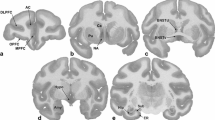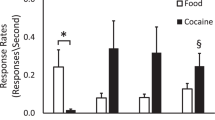Abstract
It has been suggested that the initiation and maintenance of cocaine self-administration (SA) is critically dependent on the dopaminergic (DA) projection to the medial prefrontal cortex (mPFC). Evidence for this hypothesis has been obtained from intracranial SA of cocaine, but a role of the mPFC in IV cocaine SA has not been established. The present experiment investigated the effect of destruction of DA-containing terminals in the mPFC on the rate and pattern of IV cocaine SA. Rats were trained to self-administer cocaine during daily 3-h sessions. After stable response patterns were obtained, the rats received either bilateral injections of 6-hydroxydopamine (6-OHDA) into the mPFC, or sham operations. The lesions did not affect either the rate or pattern of IV cocaine SA, despite producing substantial DA depletions in the mPFC. Thus, the mPFC does not appear to be a critical substrate for the maintenance of IV cocaine SA. The 6-OHDA lesions of the mPFC resulted in an apparent increase in DA turnover in both the striatum and the nucleus accumbens, suggesting that DA terminals in the mPFC may have an inhibitory influence on the activity of subcortical DA projections.
Similar content being viewed by others
References
Brown ZW, Amit Z, Weeks JR (1976) Simple flow-thru swivel for infusions into unrestrained animals. Pharmacol Biochem Behav 5:363–365
Bunney BS, Aghajanian GK (1977) Electrophysiological studies of dopamine-innervated cells in the frontal cortex. In: Costa E, Gessa GL (eds) Advances in biochemical psychopharmacology, vol 16, Raven Press, New York, pp 65–70
Carter CJ, Pycock CJ (1980) Behavioral and biochemical effects of dopamine and noradrenaline depletion within the medial prefrontal cortex of the rat. Brain Res 192:163–176
Collins RJ, Weeks JR, Cooper MM, Good PI, Russel RR (1984) Prediction of abuse liability of drugs using IV self-administration by rats. Psychopharmacology 82:6–13
Cools AR (1977) Two functionally and pharmacologically distinct dopamine receptors in the rat brain. In: Costa E., Gessa GL (eds) Advances in biochemical psychopharmacology, vol 16, Raven Press, New York, pp 215–225
Deminiere JM, Simon H, Herman JP, Le Moal M (1984) 6-Hydroxydopamine lesion of the dopamine mesocorticolimbic cell bodies increases (+)-amphetamine self-administration. Psychopharmacology 83:281–284
Ettenberg A, Pettit HO, Bloom FE, Koob GF (1982) Heroin and cocaine intravenous self-administration in rats: Mediation by separate neural systems. Psychopharmacology 78:204–209
Fallon JH (1982) Monoamine innervation of the forebrain: collateralization. Brain Res Bull 9:295–307
Goeders NE, Smith JE (1983) Cortical involvement in cocaine reinforcement. Science 221:773–775
Guerin GF, Goeders NE, Dworkin SI, Smith JE (1984) Intracranial self-administration of dopamine into the nucleus accumbens. Soc. Neurosci. Abstr. 14th Annual Meeting #347.5
Hoebel BG, Monaco AP, Hernandez L, Aulisi EF, Stanley BG, Lenard L (1983) Self-injection of amphetamine directly into the brain. Psychopharmacology 81:158–163
Joyce EM, Stinus L, Iversen SD (1983) Effect of injection of 6-OHDA into either nucleus accumbens septi or frontal cortex on spontaneous and drug-induced activity. Neuropharmacology 22:1141–1145
Lee EHY, Geyer MA (1984) Indirect effects of apomorphine on serotoninergic neurons in rats. Neuroscience 11:437–442
Lyness WH, Friedle NM, Moore KE (1979) Destruction of dopaminergic nerve terminals in nucleus accumbens: Effect on d-amphetamine self-administration. Pharmacol Biochem Behav 11:553–556
Mogenson GJ, Yim CY (1981) Electrophysiological and neuropharmacological — behavioral studies of the nucleus accumbens: Implications for its role as a limbic-motor interface. In: Chronister RB, De France JF (eds) The neurobiology of the nucleus accumbens, Haer Institute for Electrophysiological Research, Maine, pp 210–229
Pickens R, Thompson T (1968) Cocaine-reinforced behavior in rats: Effects of reinforcement magnitude and fixed ratio size. J Pharmacol Exp Ther 161:122–129
Pycock CJ, Carter CJ, Kerwin RW (1980) Effect of 6-hydroxydopamine lesions of the medial prefrontal cortex on neurotransmitter systems in subcortical sites in the rat. J Neurochem 34:91–99
Roberts DCS, Corcoran ME, Fibiger HC (1977) On the role of ascending catecholaminergic systems in intravenous self-administration of cocaine. Pharmacol Biochem Behav 6:615–620
Roberts DCS, Koob GF (1982) Disruption of cocaine self-administration following 6-hydroxydopamine lesions of the ventral tegmental area in rats. Pharmacol Biochem Behav 17:901–904
Roberts DCS, Koob GF, Klonoff P, Fibiger HC (1980) Extinction and recovery of cocaine self-administration following 6-hydroxydopamine lesions of the nucleus accumbens. Pharmacol Biochem Behav 12:781–787
Yokel RA, Wise RA (1976) Attenuation of intravenous amphetamine reinforcement by central dopamine blockade in rats. Psychopharmacology 48:311–318
Author information
Authors and Affiliations
Additional information
Offprint requests to: C. Szostak
Rights and permissions
About this article
Cite this article
Martin-Iverson, M.T., Szostak, C. & Fibiger, H.C. 6-Hydroxydopamine lesions of the medial prefrontal cortex fail to influence intravenous self-administration of cocaine. Psychopharmacology 88, 310–314 (1986). https://doi.org/10.1007/BF00180830
Received:
Revised:
Issue Date:
DOI: https://doi.org/10.1007/BF00180830




